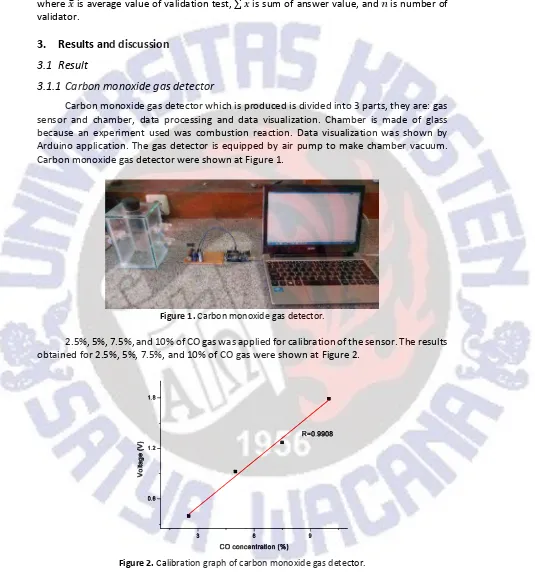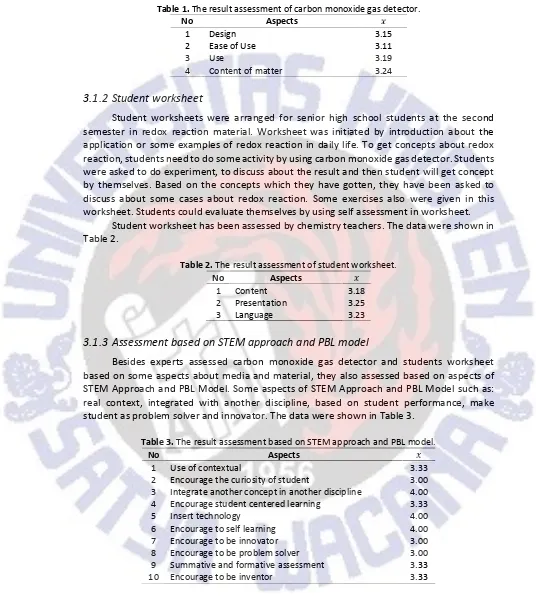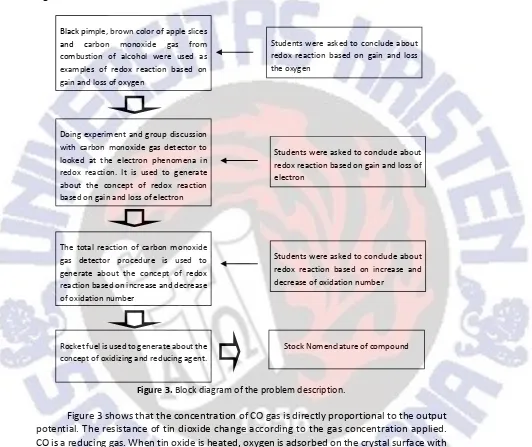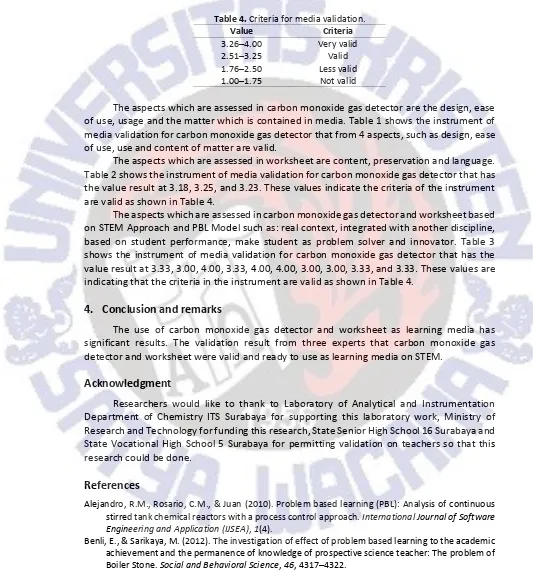Carbon monoxide gas detector as integrated chemistry learning media
on STEM (Science, Technology, Engineering, and Mathematics)
Nina Ariesta, Surya Rosa Putra, Fredy Kurniawan
Department of Chemistry, Institut Teknologi Sepuluh Nopember, Surabaya 60111, Indonesia
Abstract
Chemistry education especially in senior high school has not been integrated to other disciplines. Teachers deliver his knowledge to students by explaining a concept without showing what the relation of the concept which being to deliver with the other disciplines. Problem Based Learning (PBL) is one of the learning models which have positive impact to student s achievement and the permanence of knowledge. Using PBL model we can do STEM (Science Technology, Engineering and Mathematics) approach. By integrating chemistry concept to other disciplines using STEM approach, it will make easier for the students to understand about science holistically. In this research, we have designed carbon monoxide gas detector as learning media and STEM interactive worksheet. This learning media was expected to visualize integration of a chemistry concept to other disciplines, so in such a way can improve the student achievement. The validation of carbon monoxide gas detector and worksheet as a learning media from three expertises showed significant outcome. There are three aspects which were assessed namely: carbon monoxide gas detector, worksheet and assessment based on STEM approach with PBL model. These aspects have criteriavalidfor all the instrument criteria.
Keywords carbon monoxide gas detector, chemistry learning media, PBL, STEM
1.
Introduction
The data of PISA (Program for International Student Assessment) in 2012 showed that Indonesia was at 64thof the study conducted by the OECD (Organization for Economic
Co-operation and Development) (OECD, 2013). The quality of education in Indonesia needs to be improved, especially in sciences. It has possibility to be improved by instructional strategy. According to the interview with chemistry teachers at senior high school 16 and vocational school 5 Surabaya, most of the learning processes in class today still produce students with passive character. There are many teachers who do not encourage the student interest in a particular matter from the beginning. Student interest in early learning will determine how they learn and how they think. Teachers tend to deliver the knowledge by concept from the start and without have asked how the concept was generated. It will not make student to be active in the learning process.
helps the development of collaboration skills and intrinsic motivation (Stoica, 2012). The learning is triggered by striving to tackle a problem which may be presented in many forms such as a description of a design scenario, a curious outcome or an extreme event. Basically, students form teams, organize the work, research and negotiate a response to the problem (Alejandro, 2010). PBL can be used to improve the student achievement related to science and the permanence of information (Benli, 2012).
The Indonesia s 2013 National Curriculum was the curriculum that was focused on the output of the educational process in the form of productive, creative, innovative, affective human through the strengthening of attitudes, skills, and knowledge in multidiscipline (Depdikbud, 2013). One of learning approach which can integrated to another concept is STEM (the science, technology, engineering and mathematics). STEM is a learning approach that is integrated with a wide range of disciplines. STEM allows students to learn concepts by applying four disciplines (science, technology, engineering and mathematics) in an integrated way (Lantz, 2009). STEM eliminate the boundaries between the four disciplines by integrating these sciences in a single unit a thorough study. STEM education offers students one of the best opportunities to make sense of the world holistically, rather than in bits and pieces. STEM education removes the traditional barriers erected between the four disciplines, by integrating them into one cohesive teaching and learning paradigm. STEM is an interdisciplinary approach to learning where rigorous academic concepts are coupled with real-world lessons as students apply science, technology, engineering, and mathematics. The goal of STEM is the student can be problem solvers, innovators, inventors, self reliant, logical thinkers, and technologically literate (Morrison, 2006).
In relation STEM learning approach with PBL learning model, it is required a media that can incorporate the concept of science, technology, and math skills into the learning process. Media that could be conducted is carbon monoxide gas detector. The process of sample burning and process which are occurred in sensor involved redox reaction. So, carbon monoxide gas detector can be applied to redox matter.
2.
Materials and methods
2.1
Materials
Carbon monoxide (CO) gas detector was composed of SnO2 semiconductor based
sensor namely MQ-7. Microcontroller ATmega 328 was used for convert analog data to digital data. Ultra high purity nitrogen was purchased from PT Samator and it was used without further purification for sensor calibration. CO gas was produced by heating of sulfuric acid and acetic acid.
2.2 Methods
CO gas was produced by heating of sulfuric acid and acetic acid according to thermal method (Mattson, 2006). Amount of CO gas was injected to N2 gas stream which was
= ,
where is average value of validation test, is sum of answer value, and is number of validator.
3.
Results and discussion
3.1 Result
3.1.1 Carbon monoxide gas detector
Carbon monoxide gas detector which is produced is divided into 3 parts, they are: gas sensor and chamber, data processing and data visualization. Chamber is made of glass because an experiment used was combustion reaction. Data visualization was shown by Arduino application. The gas detector is equipped by air pump to make chamber vacuum. Carbon monoxide gas detector were shown at Figure 1.
Figure 1.Carbon monoxide gas detector.
2.5%, 5%, 7.5%, and 10% of CO gas was applied for calibration of the sensor. The results obtained for 2.5%, 5%, 7.5%, and 10% of CO gas were shown at Figure 2.
Figure 2.Calibration graph of carbon monoxide gas detector.
Table 1.The result assessment of carbon monoxide gas detector.
No Aspects
1 Design 3.15
2 Ease of Use 3.11
3 Use 3.19
4 Content of matter 3.24
3.1.2 Student worksheet
Student worksheets were arranged for senior high school students at the second semester in redox reaction material. Worksheet was initiated by introduction about the application or some examples of redox reaction in daily life. To get concepts about redox reaction, students need to do some activity by using carbon monoxide gas detector. Students were asked to do experiment, to discuss about the result and then student will get concept by themselves. Based on the concepts which they have gotten, they have been asked to discuss about some cases about redox reaction. Some exercises also were given in this worksheet. Students could evaluate themselves by using self assessment in worksheet.
Student worksheet has been assessed by chemistry teachers. The data were shown in Table 2.
Table 2.The result assessment of student worksheet.
No Aspects
1 Content 3.18
2 Presentation 3.25
3 Language 3.23
3.1.3 Assessment based on STEM approach and PBL model
Besides experts assessed carbon monoxide gas detector and students worksheet based on some aspects about media and material, they also assessed based on aspects of STEM Approach and PBL Model. Some aspects of STEM Approach and PBL Model such as: real context, integrated with another discipline, based on student performance, make student as problem solver and innovator. The data were shown in Table 3.
Table 3.The result assessment based on STEM approach and PBL model.
No Aspects
1 Use of contextual 3.33
2 Encourage the curiosity of student 3.00 3 Integrate another concept in another discipline 4.00 4 Encourage student centered learning 3.33
5 Insert technology 4.00
6 Encourage to self learning 4.00
7 Encourage to be innovator 3.00
8 Encourage to be problem solver 3.00 9 Summative and formative assessment 3.33
10 Encourage to be inventor 3.33
3.2 Discussion
generated through the reaction of carbon monoxide gas detector. Student got the concepts about redox reaction through the reactions which were occurred in carbon monoxide gas detector. Block diagram about the problem description which is conducted was shown in Figure 3.
Figure 3.Block diagram of the problem description.
Figure 3 shows that the concentration of CO gas is directly proportional to the output potential. The resistance of tin dioxide change according to the gas concentration applied. CO is a reducing gas. When tin oxide is heated, oxygen is adsorbed on the crystal surface with a negative charge. When sensor is exposed in CO gas, the particles of CO gas will be adsorbed on SnO2crystal surface, then reacts with adsorbed oxygen ion O-. Then the electrons from
the crystal surface are transferred to the adsorbed oxygen. Thererfore the resistance of tin oxide will change which affect to the output potential.
)
The reaction of carbon monoxide gas detector was used as example to get concepts about redox reaction. Reactions (1) and (2) were simplified, so that it could be understood by students easily.
Black pimple, brown color of apple slices and carbon monoxide gas from combustion of alcohol were used as examples of redox reaction based on gain and loss of oxygen
Students were asked to conclude about redox reaction based on gain and loss based on gain and loss of electron
Students were asked to conclude about redox reaction based on gain and loss of electron
The total reaction of carbon monoxide gas detector procedure is used to generate about the concept of redox reaction based on increase and decrease of oxidation number
Students were asked to conclude about redox reaction based on increase and decrease of oxidation number
Rocket fuel is used to generate about the concept of oxidizing and reducing agent.
In this research, we divide rating s value to be five ranges. Then the result of the rating is interpreted as a criterion. The criteria for media validation are such as very valid, valid, fair, less valid and not valid. Meanwhile, the criteria for student s response consists of very interesting, interesting, average, less interesting and not Interesting as seen in Table 4.
Table 4.Criteria for media validation.
Value Criteria
3.26 4.00 Very valid 2.51 3.25 Valid 1.76 2.50 Less valid 1.00 1.75 Not valid
The aspects which are assessed in carbon monoxide gas detector are the design, ease of use, usage and the matter which is contained in media. Table 1 shows the instrument of media validation for carbon monoxide gas detector that from 4 aspects, such as design, ease of use, use and content of matter are valid.
The aspects which are assessed in worksheet are content, preservation and language. Table 2 shows the instrument of media validation for carbon monoxide gas detector that has the value result at 3.18, 3.25, and 3.23. These values indicate the criteria of the instrument are valid as shown in Table 4.
The aspects which are assessed in carbon monoxide gas detector and worksheet based on STEM Approach and PBL Model such as: real context, integrated with another discipline, based on student performance, make student as problem solver and innovator. Table 3 shows the instrument of media validation for carbon monoxide gas detector that has the value result at 3.33, 3.00, 4.00, 3.33, 4.00, 4.00, 3.00, 3.00, 3.33, and 3.33. These values are indicating that the criteria in the instrument are valid as shown in Table 4.
4. Conclusion and remarks
The use of carbon monoxide gas detector and worksheet as learning media has significant results. The validation result from three experts that carbon monoxide gas detector and worksheet were valid and ready to use as learning media on STEM.
Acknowledgment
Researchers would like to thank to Laboratory of Analytical and Instrumentation Department of Chemistry ITS Surabaya for supporting this laboratory work, Ministry of Research and Technology for funding this research, State Senior High School 16 Surabaya and State Vocational High School 5 Surabaya for permitting validation on teachers so that this research could be done.
References
Alejandro, R.M., Rosario, C.M., & Juan (2010). Problem based learning (PBL): Analysis of continuous stirred tank chemical reactors with a process control approach.International Journal of Software Engineering and Application (IJSEA),1(4).
Depdikbud. (2013). Kerangka dasar dan struktur kurikulum SMA/MA. Departemen Pendidikan dan Kebudayaan, Jakarta.
Draghicescu, L.M., Patruscu, A.M., Cristea, G.C., Gorghiu, M., & Gorghiu, G. (2011). Application of problem-based learning strategy in science lessons-examples of good practice. Procedia - Social and Behavioral Sciences,149, 297 301.
OECD (2013). PISA 2012 assessment and analytical framework: Mathematics, reading, science, problem solving and financial literacy. OECD Publishing.
Lantz, H.B. (2009).Science, Technology, Engineering, and Mathematics (STEM) Education, what form? What function?
Martyn, J; Terwijn, R; Kek, M.Y.C.A. ; Huijser, H. (2014). Exploring the relationships between teaching, approaches to learning and critical thinking in a problem-based learning foundation nursing course.Nurse Educationn Today,34,829 835.
Mattson, B., Anderson, B., & Matson, S. (2006). Microscale gas chemistry. USA: Underwood Public School
Morrison, J.S. (2006).TIES STEM education monograph series, attributes of STEM education.
Stoica, A., Chiru, L., Chiru, C. (2012). Opportunity assessment for the introduction of the integrated learning unit in chemistry education.Social and Behavioral Sciences,46, 4056 4060.



